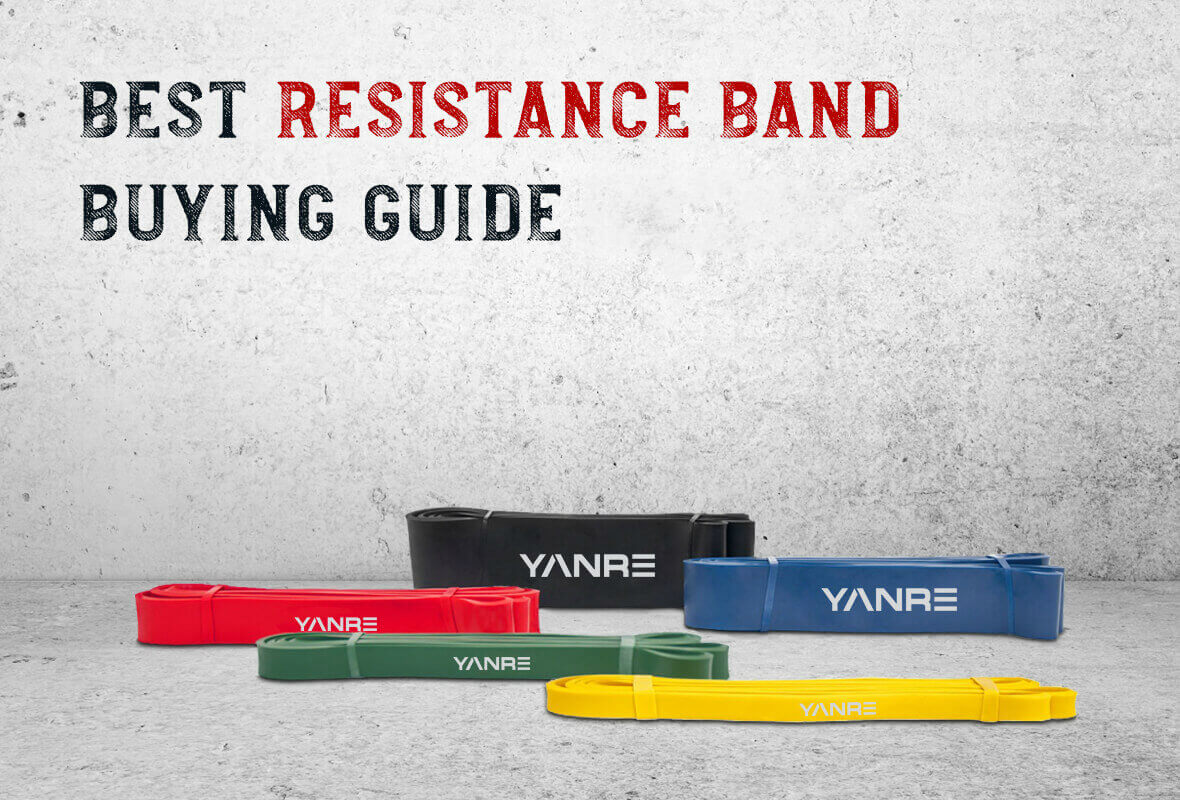Resistance bands are a simple but effective way of strength training. They are an affordable option to add to a home workout routine, as well as for commercial gyms.
They are the best way to add more resistance to various types of exercises.
Like all small gym accessories in high demand, there is no shortage of these in the market. It makes a gym owner’s job complicated when choosing resistance bands for a commercial setup.
With this article, we aim to give you a complete guide about buying resistance bands. It will help you make an informed choice.
To make it worthy of your time, we have included comments & advice from industry professionals of seven different resistance band companies.
At the end of it, you will know more about:
- The types of resistance bands
- The lifespan of resistance bands
- Properties of the best of resistance bands
- Traps to avoid when buying resistance bands
Let’s begin,
(Note: Resistance bands have many names, like workout bands, exercise bands, stretch bands, etc. For the sake of clarity, we will refer to them as resistance bands for the duration of this article)
Table of Contents
Concise Comparison Guide
You can consult this concise comparison guide to get a better idea of the quality & performance of various types of resistance bands & their construction.
It will help you reach a decision quicker & avoid any traps due to unnecessary details, as well.
(Note: All the data in the comparison chart is an approximation & resistance band facts & figures may differ slightly between different brands & manufacturers.)
Resistance Band Type Comparison Chart

Resistance Band Material Comparison Chart

Types of Resistance Bands
There are two types of resistance bands available for sale in the market:
- Flat Resistance Bands
- Tube Resistance Bands
Flat Resistance Bands
A single piece of rubber forms flat bands. These are either held by fingers or wrapped around the palms due to a lack of handles.
The use of a flat resistance band is for therapy & rehabilitation after an injury. These are perfect for working on the lower body & ankle joints.
The thickness of the band decides its resistance level. Thicker bands provide more resistance as compared to the thinner ones.
Therapy Resistance Bands
The primary function of these thin, flat bands is therapy & rehab. They are open at both ends as they don’t have circular loop handles.
Due to the increased width of these bands, the resistance is spread equally over the body. It, in turn, increases the level of flexibility.
Therapy bands are thinner & have more tensile strength.
Pros of Therapy Resistance Bands
Pros of therapy resistance bands are as follows:
- Portable
- Cost-effective (Simple design)
- Higher Flexibility
Cons of Therapy Resistance Bands
The cons of therapy bands are:
- Prone to stretching & damage
- Not for building muscle
- Difficult to grip due to lack of handles

Loop Resistance bands
These are easy to hold & anchor because they form a loop. There are three types of loop resistance bands:
- Regular
- Mini
- Power
All three types are similar in structure but differ in size.
Regular Loop Resistance Bands
A regular loop band is a continuous circular band, 4-feet in length & 1-inch wide. It is somewhat thicker & less in width than a therapy resistance band.
Regular loop bands are a well-liked option of buyers, as they support a wide range of workouts, specifically ones targeting the lower body muscle groups.

Mini Loop Resistance Bands
Structurally, a mini loop band is similar to a regular loop band. Though, it is smaller & thinner in size.
These have a lot of variety in terms of color & levels of resistance. The target muscle groups for mini loop bands are the muscles of the legs, knee & rotator cuff.
They are compact resistance bands that are portable with ease.
Pros
The pros of mini loop bands are:
- Cost-effective.
- The width of a loop band ensures equal distribution of tension, making it comfortable to use.
Cons
The cons of mini loop bands are:
- Higher resistance levels due to a shorter length.
- Easily breakable if overstretched.

Power Loop Resistance Bands
These are thicker & longer than the other two types of loop bands. They have more strength potential for higher levels of resistance training.
The pros & cons of resistance loop bands are:
Pros
The pros of power loop bands are as follows:
- Best for advanced users due to a higher resistance level.
- Thick, durable, & snap-resistant under tension.
- An efficient accessory for strength building & doing pull-ups.
Cons
The cons of power loop bands are:
- Not easily portable due to larger size.
- Costly.

Tube Resistance Bands
These resistance bands are hollow or solid rubber tubing, hence the name. Tube bands have higher versatility in terms of functionality & resistance levels.
These are more suitable for certain types of workout routines.
One of the cons of tube bands is the uneven tension along the length when anchored to an object. It compromises both the functionality & effectiveness of the exercise routine.
There are many types of tube bands, such as:
Handle or Fit Tube Resistance Bands
These are also known as fit tube bands. These have two key advantages.
The first one is the hard plastic or foam grip handle that ensures a firm & comfortable grip. While the other is an anchoring attachment for pulling or rowing exercises, such as chest presses & lateral pull-downs.
Some fit tube bands come with carabiners at the ends. The carabiners are to replace the resistance band levels. They also allow you to raise the resistance levels further by adding more bands to the handles.
Pros of Handle Resistance Bands
The pros of a handle or fit band are:
- Handle bands are handy because you don’t have to connect them to an attachment with every use.
- Two handles allow you to work on both arms at the same time.
Cons of Handle Resistance Bands
The cons for a handle or fit band are:
- Not suitable for exercises that use one of the handles at a time.
- Less effective for lower body workouts, so unable to effectively target the glutes or muscles of the leg.

Clip-tube Resistance Bands
There isn’t much difference between these & fit tube bands, other than that these have clips for attaching to handles, doors, or ankle cuffs.
Clip-tube bands have a rubber construction. Unlike handle/fit tube bands, there is the option of clipping one end if you want to train with only one side. There is the option of adding more of them to raise resistance levels.
Pros of Clip-tube Resistance Bands
The pros of clip-tube bands are:
- Versatile resistance bands supporting a wide range of workouts comparable to those done on a cable machine.
- The change in the level of resistance is uniform & even.
- The high level of flexibility makes it compatible with a variety of resistance attachments.
- Keep adding more bands to increase the resistance level slowly.
Cons of Clip-tube Resistance Bands
The cons of clip-tube bands are:
- Not easily portable due to extra accessories.
- Clip-tube bands are not snap-resistant. In case of a break, the band snaps back & there is a risk of injury to the user.
- Not suitable for bilateral use, except for when two clip-tube bands are used at the same level of resistance.

Ring Resistance Bands
These resistance bands are compact rings withs handles on both sides. Almost one foot long, these bands have soft plastic handles.
It is the main point of difference between these & handle tube bands with hard plastic handles. Soft handles are comfortable to use & ensure a firm grip, as well.
Ring resistance bands are specific to lower limb exercises. They are similar to loop bands, as well. Though, loop bands are flat bands, while these are tube-shaped.

Figure-8 Resistance Bands
Another name for these resistance bands is bow-tie bands. They have a latex rubber construction. The central rubber sleeve has soft rubber handles on both sides.
These are specific to upper limb exercises due to their shorter length & soft handles. Figure-8 bands bring you the benefits of both tube & flat resistance bands.
Pros of Figure-8 Resistance Bands
The pros of figure-8 resistance bands are:
- Comfortable to use because of the soft plastic handles.
- Affordable compared to other types of tube resistance bands.
Cons of Figure-8 Resistance Bands
The cons of figure-8 resistance bands are as follows:
- Redistricted range of motion.
- Supports fewer workout routines comparatively.
- Not for lower limb workouts.

Construction of Resistance Bands
The construction of a resistance band decides its quality & lifespan. Usually, commercial band manufacturers use three types of materials. These include:
- Latex Bands
- Non-latex or TPE bands
- Fabric Bands
Latex Material Resistance Bands
Latex is an organic material. It is natural rubber that comes from rubber trees. The production process involves cutting into the tree & collecting the white liquid that comes out.
This liquid undergoes processing & molding to form latex.
About 90% of the commercial resistance bands in the wholesale market have latex construction.
Pros of Latex Material
The pros of latex resistance bands are as follows:
- Versatile resistance levels: The resistance levels for natural rubber range from low to high, making latex bands suitable for all users & exercises.
- Tensile Strength & Elasticity: The elasticity & tensile strength of latex is very high.
- ROM: The extensive range of motion helps to avoid injuries & makes the resistance bands highly flexible.
- Low-maintenance: The smooth surface of these resistance bands doesn’t absorb dust or grime. It is low-maintenance & simple to clean.
- Portability: Latex bands are easily portable because they are lightweight & compact.
Cons of Latex Material
The cons of latex resistance bands are as follows:
- Sensitive to Ozone & UV radiation & direct sunlight exposure.
- Low tolerance for high temps.
- Users may be allergic to latex.
- Rubber odor
- Not slip-resistant in wet conditions.

Non-latex or TPE Material Resistance Bands
TPE is the synthetic replacement for rubber. TPE is a ThermoPlastic Elastomer that comes from petroleum.
Unlike natural rubber, TPE doesn’t trigger any allergies in sensitive individuals.
Pros of TPE
The pros of TPE material are as follows:
- Anti-allergic Nature: TPE is chemically inert & doesn’t trigger an immune response in sensitive users.
- Ozone & UV-resistant: It is resistant to damage from Ozone, UV rays, or direct sunlight.
- Temperature Resistant: TPE tolerates higher temperatures well.
- Elasticity & Tensile Strength: Both are within range, even if they are somewhat lower than latex.
- Long-lasting: TPE has a longer lifespan than natural rubber.
Cons of TPE
The one con of TPE material is:
- It is neither biodegradable nor eco-friendly.

Fabric Material Resistance Bands
Fabric is a mixture of flexible fabric material & latex. It is available in a wide range of colors & patterns.
Fabric bands are easy to use, smoother, & softer on the skin. They promote a firm grip & are slip-resistant, irrespective of the type of movement.
Pros of Fabric
The pros of fabric material are as follows:
- Resistant to slipping or sliding.
- Resistant to Ozone & UV radiation.
- Softer on the skin.
- Not prone to triggering an allergic response.
- Biodegradable & eco-friendly.
Cons of Fabric
The cons of fabric material are as follows:
- Elasticity: Fabric is flexible, though they are not flexible enough. It restricts the effective range of motion of the material, limiting the exercises it will support.
- Resistance Range: Fabric has high resistance levels. It makes fabric bands unsuitable for very young & old users, as well as those undergoing rehab.
- High-Maintenance: Fabric bands require regular cleaning because they get dirty quickly. They are machine washable.
- Portability: Fabric bands are bulkier, need more storage space & are heavier. All these factors decrease their portability.
- Costly.

Properties of Resistance Bands
Construction
The properties of resistance bands vary based on construction & type.
Flat Resistance Bands:
Continuous layering technology makes flat bands highly durable. It is necessary to prevent any tearing, as well.
Though, the whole process is complex & takes a lot of time. So, flat bands are an expensive choice.
Tube Resistance Bands
Resistance cords is a process for making highly durable tube bands. It involves weaving several tubules together.
For a long-lasting finish, the surface should be seamless. Tube bands with visible seams are not a good choice for commercial resistance bands.
Level of Resistance
The resistance levels for wholesale bands differ with tube thickness for tube bands & the rubber construction for flat bands.
Commercial bands come with color-coding according to the resistance level. It varies between brands & manufacturers.
The yellow color stands for the lowest level of resistance.
Below is an example of a color-coding chart from one resistance band manufacturer:

Comfort Level
To ensure comfortable use, the material of the resistance band must be soft. Softer materials promote a firm grip & prevent warts & calluses.
The resistance band itself should have a width that won’t injure or cause damage during stretching.
Resistance bands with add-ons such as handles, clip-on, cuffs may cost more but are an investment in the long run & ensure a secure grip.
The add-ons & accessories make resistance bands versatile & hardwearing.
Tips and Traps of Buying Commercial Resistance Bands
Below are some useful tips to consider and trap to avoid if you are thinking of placing a wholesale order for resistance bands.
- Safety Levels: Avoid buying cheap & mediocre resistance bands. They are not snap-resistance & may result in an otherwise avoidable injury. Choose durable resistance bands to prevent such an event. Carefully look for any cracks, holes, or seams before committing to buying a product.
- Purpose: The range of motion differs between various resistance bands. Check for it carefully before buying.
- Construction: The material of the resistance band is important. People with a sensitive immune system or those with latex allergies should look for TPE or fabric resistance bands.
- Color-coding: The color-coding of resistance bands relates to the resistance level. It varies between manufacturers. Make yourself familiar with the manufacturer’s color-coding system, so that you buy the correct resistance level.
Avoid manufacturers that do not offer a range of colors or resistance levels.
- Comfort & Convenience: Comfort level of a resistance band should be a top priority for any buyer. There are bands with replaceable handles available. It makes it easy to use other resistance bands with the same handles. Hard plastic handles are not the best choice for a comfortable grip.
If at all possible, check for the comfort level by trying the resistance band yourself.
Conclusion
Take your time & do careful research before placing a wholesale order for resistance bands for your commercial gym.
It will help you buy long-lasting, hardwearing, & functional resistance bands.
This article is a concise buying guide for all kinds of resistance bands. It will help you make a more informed choice.
To choose a highly durable & versatile resistance band, you can come and visit our website. We have a wide range of color-coding options available for our customers.
Don’t wait.
Contact us & ask for a quote now!
Related acticles:






